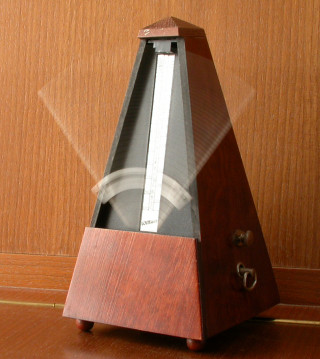1.Beat
Have you ever heard your heart beat? If you pay attention when you are alone you can hear a continuous ticking"tick" continuo, each one being a beat or a pulse. When you listen to a song you can also feel the same thing, can´t you? When talking about music the beat must be constant and regular.
2.Tempo
The tempo of a piece of music is its speed or, in other words, the beat speed. There are two ways of specifying a tempo. Metronome markingsindicaciones metronómicas are absolute and specific, they are given in beats per minute. A metronome is a musical tool that can give a beat-per-minute tempo as a ticking sound. Other tempo markings are verbal descriptions which are more relative and subjective. Both types of markings usually appear above the staffsobre el pentagrama, at the beginning of the piece.
2.1. Tempo Terms
A tempo marking is a word or phrase that expresses the composer’s idea of how fast the music should be feltcomo de rápida debe ser sentida la música. How fast a piece of music is felt depends on several different things, including the texture and complexity of the musicla textura y complejidad de la música. Tempo instructions are traditionally given in Italian. Some common tempo markings are:
Grave - very slow and solemn
Largo - quite slow
Adagio - slow
Andante - literally "walking", a medium slow tempo
Moderato - moderate, or medium
Allegro - fast
Vivo, or Vivace - lively
Presto - very fast
Usually, tempo indications may be accompanied by other Italian words:
(un) poco - a little
molto - a lot
piu - more
meno - less
mosso - literally "moved"; motion or movement
2.2. Gradual Tempo Changes
Gradual changes in the basic tempo are also common in music, and these have their own set of terms:
Accelerando - (abbreviated accel.) accelerating; getting faster
Ritardando - (abbrev. rit.) slowing down
Ritenuto - (abbrev. riten.) slower
Rallentando - (abbrev. rall.) gradually slower
3. Accent, measure and rhythm
Measure organizes the beats or pulsations in groups of two, three and four. A measure (or bar) is like a pattern of a group of beatsun patrón de un grupo de pulsos which begin with a stressed beatpulso acentuado. This stressed beat is the natural accent of the measure and always falls on the first beat.
Music cannot exist without time. The placement of the sounds in time is the rhythm of a piece of music. Since music must be heard over a period of time, rhythm is one of the most basic elements of music.
It is very common to find measures having groups of two, three or four beats. We call them duple, triple and quadruple meterscompases binarios, ternarios y cuaternarios. The time signature appears at the beginning of a piece of music. The meter of a piece of music (the measure) is its basic rhythm; the time signature is the symbol that tells you the measure of the piece and how (with what type of note) it is written. To separate measures we use the barline.
The time signature tells you two things: how many beats are in each measure, and what type of note gets a beat.
PRACTICE




No hay comentarios :
Publicar un comentario